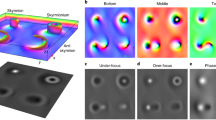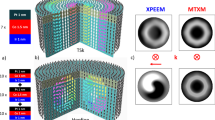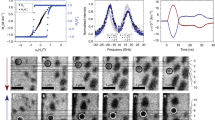Abstract
Magnetic skyrmions are chiral spin structures with a whirling configuration. Their topological properties, nanometre size and the fact that they can be moved by small current densities have opened a new paradigm for the manipulation of magnetization at the nanoscale. Chiral skyrmion structures have so far been experimentally demonstrated only in bulk materials and in epitaxial ultrathin films, and under an external magnetic field or at low temperature. Here, we report on the observation of stable skyrmions in sputtered ultrathin Pt/Co/MgO nanostructures at room temperature and zero external magnetic field. We use high lateral resolution X-ray magnetic circular dichroism microscopy to image their chiral Néel internal structure, which we explain as due to the large strength of the Dzyaloshinskii–Moriya interaction as revealed by spin wave spectroscopy measurements. Our results are substantiated by micromagnetic simulations and numerical models, which allow the identification of the physical mechanisms governing the size and stability of the skyrmions.
This is a preview of subscription content, access via your institution
Access options
Subscribe to this journal
Receive 12 print issues and online access
$259.00 per year
only $21.58 per issue
Buy this article
- Purchase on Springer Link
- Instant access to full article PDF
Prices may be subject to local taxes which are calculated during checkout






Similar content being viewed by others
Change history
18 July 2017
In the version of this Article originally published, the Dzyaloshinskii-Moriya interaction parameter, D, should have been multiplied by √3. The vertical scale of Fig. 2 has been updated accordingly as has the following sentence concerning D values: "For 5 monolayers (ML) of Co, equivalent to a total Co thickness of 1 nm, the ab initio calculations predict = 4.0 mJ m-2 whereas a lower value D = 2.6 mJ m-2 is predicted for a Pt/Co/vacuum structure." Additionally the Methods and Supplementary Information have been updated to correct the experimental multilayer composition to: "Ta(3)/Pt(3)/Co(0.5-1)/MgOx/Ta(2) (thickness in nm)".
References
Bogdanov, A. N. & Yablonskii, D. Thermodynamically stable “vortices” in magnetically ordered crystals. the mixed state of magnets. J. Exp. Theor. Phys. 95, 178 (1989).
Rößler, U. K., Bogdanov, A. N. & Pfleiderer, C. Spontaneous skyrmion ground states in magnetic metals. Nature 442, 797–801 (2006).
Mühlbauer, S. et al. Skyrmion lattice in a chiral magnet. Science 323, 915–919 (2009).
Pappas, C. et al. Chiral paramagnetic skyrmion-like phase in MnSi. Phys. Rev. Lett. 102, 197202 (2009).
Yu, X. Z. et al. Real-space observation of a two-dimensional skyrmion crystal. Nature 465, 901–904 (2010).
Nagaosa, N. & Tokura, Y. Topological properties and dynamics of magnetic skyrmions. Nature Nanotech. 8, 899–911 (2013).
Fert, A., Cros, V. & Sampaio, J. Skyrmions on the track. Nature Nanotech. 8, 152–156 (2013).
Braun, H.-B. Topological effects in nanomagnetism: from superparamagnetism to chiral quantum solitons. Adv. Phys. 61, 1–116 (2012).
Moriya, T. Anisotropic superexchange interaction and weak Ferromagnetism. Phys. Rev. 120, 91–98 (1960).
Dzyaloshinskii, I. E. Sov. Phys. JETP 5, 1259 (1957).
Jonietz, F. et al. Spin transfer torques in MnSi at ultralow current densities. Science 330, 1648–1651 (2010).
Schulz, T. et al. Emergent electrodynamics of skyrmions in a chiral magnet. Nat Phys 8, 301–304 (2012).
Yu, X. Z. et al. Skyrmion flow near room temperature in an ultralow current density. Nature Commun. 3, 988 (2012).
Jiang, W. et al. Blowing magnetic skyrmion bubbles. Science 349, 283 (2015).
Koshibae, W. et al. Memory functions of magnetic skyrmions. Japan. J. Appl. Phys. 54, 053001 (2015).
Zhang, X., Ezawa, M. & Zhou, Y. Magnetic skyrmion logic gates: conversion, duplication and merging of skyrmions. Sci. Rep. 5, 9400 (2015).
Moutafis, C., Komineas, S. & Bland, J. A. C. Dynamics and switching processes for magnetic bubbles in nanoelements. Phys. Rev. B 79, 224429 (2009).
Büttner, F. et al. Dynamics and inertia of skyrmionic spin structures. Nature Phys. 11, 225–228 (2015).
Sampaio, J., Cros, V., Rohart, S., Thiaville, A. & Fert, A. Nucleation, stability and current-induced motion of isolated magnetic skyrmions in nanostructures. Nature Nanotech. 8, 839–844 (2013).
Tomasello, R. et al. A strategy for the design of skyrmion racetrack memories. Sci. Rep. 4, 6784 (2014).
Iwasaki, J., Mochizuki, M. & Nagaosa, N. Current-induced skyrmion dynamics in constricted geometries. Nature Nanotech. 8, 742–747 (2013).
Zhou, Y. & Ezawa, M. A reversible conversion between a skyrmion and a domain-wall pair in a junction geometry. Nature Commun. 5, 4652 (2014).
Zhang, X. et al. Skyrmion-skyrmion and skyrmion-edge repulsions in skyrmion-based racetrack memory. Sci. Rep. 5, 7643 (2015).
Yu, X. Z. et al. Real-space observation of a two-dimensional skyrmion crystal. Nature 465, 901–904 (2010).
Yu, X. Z. et al. Near room-temperature formation of a skyrmion crystal in thin-films of the helimagnet FeGe. Nature Mater. 10, 106–109 (2011).
Shibata, K. et al. Towards control of the size and helicity of skyrmions in helimagnetic alloys by spin-orbit coupling. Nature Nanotech. 8, 723–728 (2013).
Heinze, S. et al. Spontaneous atomic-scale magnetic skyrmion lattice in two dimensions. Nature Phys. 7, 713–718 (2011).
Romming, N. et al. Writing and deleting single magnetic skyrmions. Science 341, 636–639 (2013).
Romming, N., Kubetzka, A., Hanneken, C., von Bergmann, K. & Wiesendanger, R. Field-dependent size and shape of single magnetic skyrmions. Phys. Rev. Lett. 114, 177203 (2015).
Bogdanov, A. & Hubert, A. Thermodynamically stable magnetic vortex states in magnetic crystals. J. Magn. Magn. Mater. 138, 255–269 (1994).
Bogdanov, A. & Hubert, A. The stability of vortex-like structures in uniaxial ferromagnets. J. Magn. Magn. Mater. 195, 182–192 (1999).
Sonntag, A., Hermenau, J., Krause, S. & Wiesendanger, R. Thermal stability of an interface-stabilized skyrmion lattice. Phys. Rev. Lett. 113, 077202 (2014).
Monso, S. et al. Crossover from in-plane to perpendicular anisotropy in Pt/CoFe/AlOx sandwiches as a function of Al oxidation: A very accurate control of the oxidation of tunnel barriers. Appl. Phys. Lett. 80, 4157–4159 (2002).
Rohart, S. & Thiaville, A. Skyrmion confinement in ultrathin film nanostructures in the presence of Dzyaloshinskii-Moriya interaction. Phys. Rev. B 88, 184422 (2013).
Freimuth, F., Blügel, S. & Mokrousov, Y. Berry phase theory of Dzyaloshinskii–Moriya interaction and spin–orbit torques. J. Phys. Condens. Matter 26, 104202 (2014).
Emori, S. et al. Spin hall torque magnetometry of Dzyaloshinskii domain walls. Phys. Rev. B 90, 184427 (2014).
Pizzini, S. et al. Chirality-induced asymmetric magnetic nucleation in Pt/Co/AlOx ultrathin microstructures. Phys. Rev. Lett. 113, 047203 (2014).
Di, K. et al. Asymmetric spin-wave dispersion due to Dzyaloshinskii-Moriya interaction in an ultrathin Pt/CoFeB film. Appl. Phys. Lett. 106, 052403 (2015).
Nembach, H. T., Shaw, J. M., Weiler, M., Jué, E. & Silva, T. J. Linear relation between Heisenberg exchange and interfacial Dzyaloshinskii-Moriya interaction in metal films. Nature Phys. 11, 825–829 (2015).
Stashkevich, A. A. et al. Experimental study of spin-wave dispersion in Py/Pt film structures in the presence of an interface Dzyaloshinskii-Moriya interaction. Phys. Rev. B 91, 214409 (2015).
Belmeguenai, M. et al. Interfacial Dzyaloshinskii-Moriya interaction in perpendicularly magnetized Pt/Co/AlOx ultrathin films measured by Brillouin light spectroscopy. Phys. Rev. B 91, 180405 (2015).
Yang, H., Thiaville, A., Rohart, S., Fert, A. & Chshiev, M. Anatomy of Dzyaloshinskii–Moriya interaction at Co/Pt interfaces. Phys. Rev. Lett. 115, 267210 (2015).
Chen, G. et al. Novel chiral magnetic domain wall structure in Fe/ Ni/Cu(001) films. Phys. Rev. Lett. 110, 177204 (2013).
Tetienne, J.-P. et al. The nature of domain walls in ultrathin ferromagnets revealed by scanning nanomagnetometry. Nature Commun. 6, 6733 (2015).
Miron, I. M. et al. Perpendicular switching of a single ferromagnetic layer induced by in-plane current injection. Nature 476, 189–193 (2011).
Garello, K. et al. Symmetry and magnitude of spin-orbit torques in ferromagnetic heterostructures. Nature Nanotech. 8, 587–593 (2013).
Miron, I. M. et al. Fast current-induced domain-wall motion controlled by the Rashba effect. Nature Mater. 10, 419–423 (2011).
Thiaville, A., Rohart, S., Jué, É., Cros, V. & Fert, A. Dynamics of Dzyaloshinskii domain walls in ultrathin magnetic films. Europhys. Lett. 100, 57002 (2012).
Moreau-Luchaire, C. et al. Additive interfacial chiral interaction in multilayers for stabilization of small individual skyrmions at room temperature. Nature Nanotech. http://dx.doi.org/10.1038/nnano.2015.313 (2016).
Woo, S. et al. Observation of room temperature magnetic skyrmions and their current-driven dynamics in ultrathin Co films. Preprint at http://arxiv.org/abs/1502.07376 (2015).
Slonczewski, J. & Malozemoff, A. P. Magnetic Domain Walls in Bubble Materials (Academic, 1979).
Hehn, M. et al. Nanoscale magnetic domains in mesoscopic magnets. Science 272, 1782–1785 (1996).
Moutafis, C. et al. Magnetic bubbles in FePt nanodots with perpendicular anisotropy. Phys. Rev. B 76, 104426 (2007).
Braun, H.-B. Fluctuations and instabilities of ferromagnetic domain-wall pairs in an external magnetic field. Phys. Rev. B 50, 16485–16500 (1994).
Kubetzka, A., Pietzsch, O., Bode, M. & Wiesendanger, R. Spin-polarized scanning tunneling microscopy study of 360° walls in an external magnetic field. Phys. Rev. B 67, 020401 (2003).
Metaxas, P. J. et al. Creep and flow regimes of magnetic domain-wall motion in ultrathin Pt/Co/Pt films with perpendicular anisotropy. Phys. Rev. Lett. 99, 217208 (2007).
Kiselev, N. S., Bogdanov, A. N., Schäfer, R. & Rößler, U. K. Chiral skyrmions in thin magnetic films: new objects for magnetic storage technologies? J. Phys. D 44, 392001 (2011).
Braun, H.-B. Nucleation in ferromagnetic nanowires—magnetostatics and topology. J. Appl. Phys. 85, 6172–6174 (1999).
Guslienko, K. Skyrmion state stability in magnetic nanodots with perpendicular anisotropy. IEEE Magn. Lett. 6, 1–4 (2015).
Chen, G., Mascaraque, A., N'Diaye, A. T. & Schmid, A. K. Room temperature skyrmion ground state stabilized through interlayer exchange coupling. Appl. Phys. Lett. 106, 242404 (2015).
Menteş, T. O., Zamborlini, G., Sala, A. & Locatelli, A. Beilstein J. Nanotechnol. 5, 1873886 (2014).
Aballe, L., Foerster, M., Pellegrin, E., Nicolas, J. & Ferrer, S. The ALBA spectroscopic LEEM-PEEM experimental station: layout and performance. J. Synchrotron Radiat. 22, 745–752 (2015).
Buda, L. D., Prejbeanu, I. L., Ebels, U. & Ounadjela, K. Micromagnetic simulations of magnetisation in circular cobalt dots. Comput. Mater. Sci. 24, 181 (2002).
Vansteenkiste, A. & Van de Wiele, B. MuMax: A new high-performance micromagnetic simulation tool. J. Magn. Magn. Mater. 323, 2585–2591 (2011).
Donahue, M. J. & Porter, D. G. OOMMF User's Guide version 1.0 (National Institute of Standards and Technology, 1999).
Acknowledgements
The authors would like to thank A. Thiaville, M. Cubukcu, L. Camosi, M. Caminale and W. Savero-Torres for discussions and their help in experiments. For their contribution to the CIRCE beamline at the Alba synchrotron, we would like to thank C. Escudero, V. Perez-Dieste, E. Pellegrin, J. Nicolas and S. Ferrer. S.P. and J.V. acknowledge the support of the Agence Nationale de la Recherche, project ANR-14-CE26-0012 (ULTRASKY).
Author information
Authors and Affiliations
Contributions
O.B. conceived and designed the experiments. O.B., J.V., S.P., D.S.C., A.L, T.O.M., A.S., L.A., M.F. participated in the XMCD-PEEM experiments. O.B and J.V. analysed the microscopy data. H.Y. and M.C. carried out the ab initio calculations. O.B., L.B-D. and O.K. carried out the micromagnetic simulations, O.B. carried out the numerical calculations, S.A. deposited the magnetic multilayers, M.B., Y.R., A.S. carried out the BLS experiments. O.B. wrote the manuscript. All authors discussed the results and commented on the manuscript.
Corresponding author
Ethics declarations
Competing interests
The authors declare no competing financial interests.
Supplementary information
Supplementary information
Supplementary information (PDF 564 kb)
Rights and permissions
About this article
Cite this article
Boulle, O., Vogel, J., Yang, H. et al. Room-temperature chiral magnetic skyrmions in ultrathin magnetic nanostructures. Nature Nanotech 11, 449–454 (2016). https://doi.org/10.1038/nnano.2015.315
Received:
Accepted:
Published:
Issue Date:
DOI: https://doi.org/10.1038/nnano.2015.315
This article is cited by
-
Dipolar skyrmions and antiskyrmions of arbitrary topological charge at room temperature
Nature Physics (2024)
-
The influence of chiral arrangement in the magnetocaloric and thermoelectric properties of the intermetallic CeMn2Si2 compound: a first-principle and Monte Carlo simulation
Indian Journal of Physics (2024)
-
Controllable nucleation and deformation of skyrmions on surface of magnetic nanotubular monolayer
Rare Metals (2024)
-
Enhanced thermally-activated skyrmion diffusion with tunable effective gyrotropic force
Nature Communications (2023)
-
Stabilization and racetrack application of asymmetric Néel skyrmions in hybrid nanostructures
Scientific Reports (2023)



